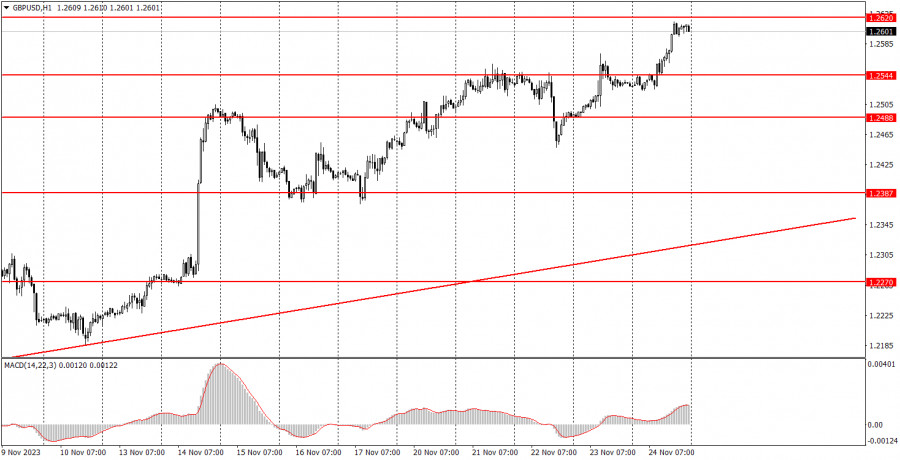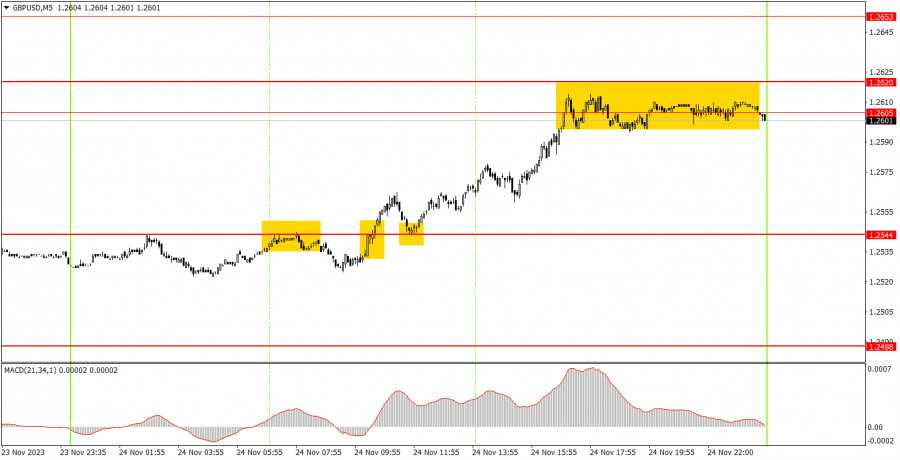

The GBP/USD pair continued to trade higher on Friday. We have repeatedly mentioned that it has been illogical for the pound to rise further, but at the same time, the uptrend remains intact, and the trendline is present. Therefore, the pair will continue to rise until the current trend is broken. On Friday, there was no interesting event in the UK that could provoke an upward movement. Nevertheless, the price started moving up practically from the morning. During the US session, three reports on business activity in the US were released, but the data turned out mixed, as one report was stronger than expected, the second was weaker, and the third is of little interest to us.
GBP/USD on 5M chart
On the 5-minute chart, several trading signals were generated. The first sell signal around the 1.2544 level turned out to be false, and the price could not fall by 20 pips. Therefore, the short position closed at a loss when the price formed the next buy signal around the same level of 1.2544. An hour later, a duplicate buy signal was formed as a bounce from 1.2544 from above. Beginners could open a long position based on these two signals. Subsequently, the price rose to the area of 1.2605-1.2620, and the trade should be closed manually. The profit on it was 45 pips, which covered the loss on the first trade and allowed for a small profit.
Trading tips on Monday:On the 30-minute chart, the GBP/USD pair continues an uptrend. The anticipation is for this to conclude. Currently, we have an ascending trend line, and overcoming it will allow us to determine the end of the uptrend. The long-awaited decline finally started, but ended very quickly. Now, we need the price to drop at least to the trendline. The key levels on the 5M chart are 1.2164-1.2179, 1.2235, 1.2270, 1.2310, 1.2372-1.2387, 1.2457-1.2488, 1.2544, 1.2605-1.2620, 1.2653, 1.2688, 1.2748. Once the price moves 20 pips in the right direction after opening a trade, you can set the stop-loss at breakeven. On Monday, there are no important events or reports lined up in the UK or the US. It is unlikely that we will see high volatility.
Basic trading rules:1) Signal strength is determined by the time taken for its formation (either a bounce or level breach). A shorter formation time indicates a stronger signal.
2) If two or more trades around a certain level are initiated based on false signals, subsequent signals from that level should be disregarded.
3) In a flat market, any currency pair can produce multiple false signals or none at all. In any case, the flat trend is not the best condition for trading.
4) Trading activities are confined between the onset of the European session and mid-way through the U.S. session, after which all open trades should be manually closed.
5) On the 30-minute timeframe, trades based on MACD signals are only advisable amidst substantial volatility and an established trend, confirmed either by a trendline or trend channel.
6) If two levels lie closely together (ranging from 5 to 15 pips apart), they should be considered as a support or resistance zone.
How to read charts:Support and Resistance price levels can serve as targets when buying or selling. You can place Take Profit levels near them.
Red lines represent channels or trend lines, depicting the current market trend and indicating the preferable trading direction.
The MACD(14,22,3) indicator, encompassing both the histogram and signal line, acts as an auxiliary tool and can also be used as a signal source.
Significant speeches and reports (always noted in the news calendar) can profoundly influence the price dynamics. Hence, trading during their release calls for heightened caution. It may be reasonable to exit the market to prevent abrupt price reversals against the prevailing trend.
Beginners should always remember that not every trade will yield profit. Establishing a clear strategy coupled with sound money management is the cornerstone of sustained trading success.